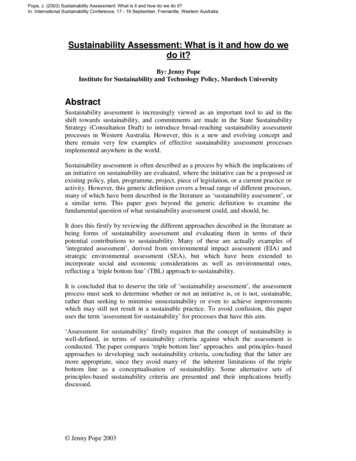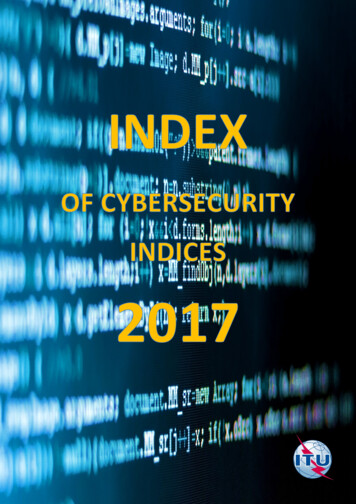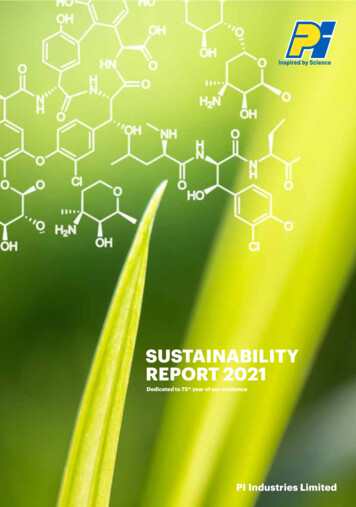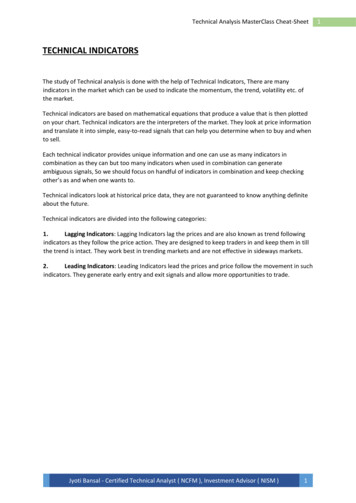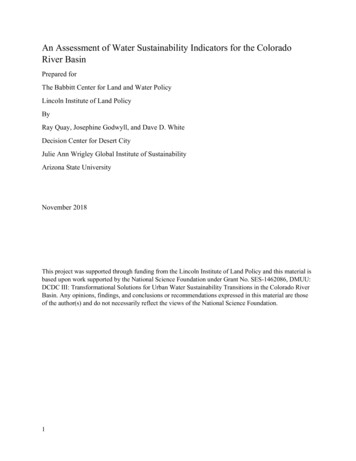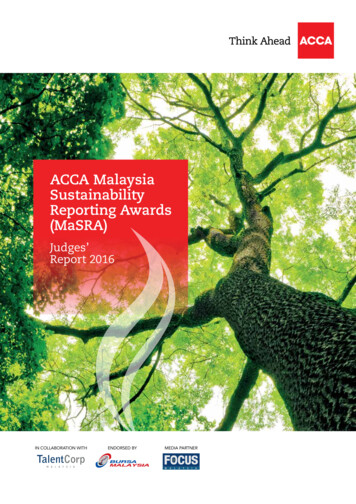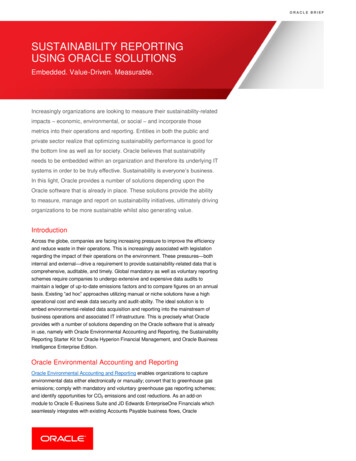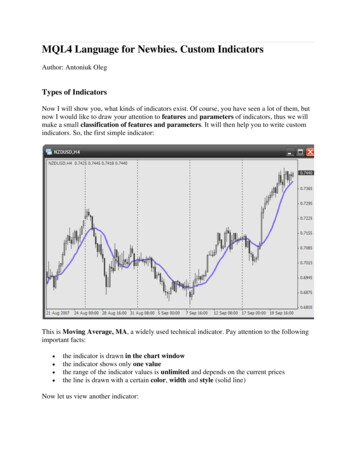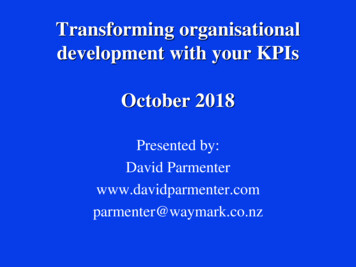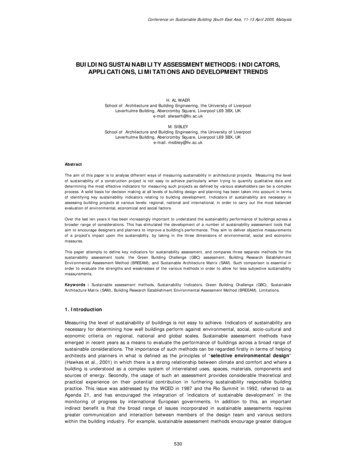
Transcription
Conference on Sustainable Building South East Asia, 11-13 April 2005, MalaysiaBUILDING SUSTAINABILITY ASSESSMENT METHODS: INDICATORS,APPLICATIONS, LIMITATIONS AND DEVELOPMENT TRENDSH. AL WAERSchool of Architecture and Building Engineering, the University of LiverpoolLeverhulme Building, Abercromby Square, Liverpool L69 3BX, UKe-mail: alwaerh@liv.ac.ukM. SIBLEYSchool of Architecture and Building Engineering, the University of LiverpoolLeverhulme Building, Abercromby Square, Liverpool L69 3BX, UKe-mail: msibley@liv.ac.ukAbstractThe aim of this paper is to analyse different ways of measuring sustainability in architectural projects. Measuring the levelof sustainability of a construction project is not easy to achieve particularly when trying to quantify qualitative data anddetermining the most effective indicators for measuring such projects as defined by various stakeholders can be a complexprocess. A solid basis for decision making at all levels of building design and planning has been taken into account in termsof identifying key sustainability indicators relating to building development. Indicators of sustainability are necessary inassessing building projects at various levels: regional, national and international, in order to carry out the most balancedevaluation of environmental, economical and social factors.Over the last ten years it has been increasingly important to understand the sustainability performance of buildings across abroader range of considerations. This has stimulated the development of a number of sustainability assessment tools thataim to encourage designers and planners to improve a building’s performance. They aim to deliver objective measurementsof a project’s impact upon the sustainability, by taking in the three dimensions of environmental, social and economicmeasures.This paper attempts to define key indicators for sustainability assessment, and compares three separate methods for thesustainability assessment tools: the Green Building Challenge (GBC) assessment; Building Research EstablishmentEnvironmental Assessment Method (BREEAM); and Sustainable Architecture Matrix (SAM). Such comparison is essential inorder to evaluate the strengths and weaknesses of the various methods in order to allow for less subjective sustainabilitymeasurements.Keywords : Sustainable assessment methods, Sustainability Indicators, Green Building Challenge (GBC), SustainableArchitecture Matrix (SAM), Building Research Establishment Environmental Assessment Method (BREEAM), Limitations.1. IntroductionMeasuring the level of sustainability of buildings is not easy to achieve. Indicators of sustainability arenecessary for determining how well buildings perform against environmental, social, socio-cultural andeconomic criteria on regional, national and global scales. Sustainable assessment methods haveemerged in recent years as a means to evaluate the performance of buildings across a broad range ofsustainable considerations. The importance of such methods can be regarded firstly in terms of helpingarchitects and planners in what is defined as the principles of “selective environmental design”(Hawkes et al., 2001) in which there is a strong relationship between climate and comfort and where abuilding is understood as a complex system of interrelated uses, spaces, materials, components andsources of energy. Secondly, the usage of such an assessment provides considerable theoretical andpractical experience on their potential contribution in furthering sustainability responsible buildingpractice. This issue was addressed by the WCED in 1987 and the Rio Summit in 1992, referred to asAgenda 21, and has encouraged the integration of ‘indicators of sustainable development’ in themonitoring of progress by international European governments. In addition to this, an importantindirect benefit is that the broad range of issues incorporated in sustainable assessments requiresgreater communication and interaction between members of the design team and various sectorswithin the building industry. For example, sustainable assessment methods encourage greater dialogue530
Al Waer & Sibleyand teamwork. This paper as a result addresses the differences between the notion of sustainabilityand green indicators, and what are called effective indicators. It identifies some of the key limitations ofexisting building sustainable assessment methods and discusses the emerging importance of issuessuch as indicators, applications and development trends. These are presented as a basis for providing apositive direction for the emergence of less subjective sustainable methods and protocols.The ‘Green’ Assessment Agenda? Assessment implies measuring how well or poorly a building isreacting, or is likely to perform, against a set range of criteria and indicators, named over a period oftime: “green design”, “ecological design” or “sustainable design”. The distinction between the notions“Green indicators” and “Sustainable indicators” is critical in what structures sustainable assessmentmethods. In the early stages of the development of assessment methods ‘green’ as a concept hasreferred to design that maximizes the use of solar energy, day lighting and natural ventilation, as wellas the harvest of rainwater, treatment of any waste on site and the use of environmentally soundmaterials. Applying the notion of green has a high market value and green buildings are moreexpensive than standard buildings. In other words, green buildings are proposed to have additionalfeatures to normal buildings and these additional features must carry with them additional costs.Meanwhile, the application of sustainable principles to building design usually lead to more simplesolutions (for instance, smaller mass and energy flows), which by contrast with green application areless expensive in investments associated with running costs (Kohler, 1999) .Sustainable Development. In terms of assessment scale, “green” assessment models place a higheremphasis on comparing performance on a regional and local scale, placing less focus on national andinternational comparability. Hence, sustainability has emerged to cover the broader concept for theenvironmental assessment methods. Such a concept is called Sustainable Development (SD) whichattempts to address the conflict between protecting the environment and natural resources, andanswering the development needs of the human race. However, it is believed that sustainabledevelopment would not be possible without certain social and economic changes; SD hasenvironmental, social and economic dimensions including all factors of human activity such as industry,transportation, food production, and so on. “A development which is respectful of the environment,technically appropriate, economically viable and socially acceptable to meet the needs of presentgenerations without compromising the ability of future generations to meet their own needs” (UNEP/MAP/Blue Plan, 2000).As to the application of sustainable development, unlike that of green architecture, it takes intoconsideration overlapping sustainability dimensions along with the wider scope of an assessment scalefrom the building itself to national and global scales. What can be added in terms of the integration ofeconomic and social considerations is that environmental measures must not lead to a sociallyunacceptable development. Instead, sustainable development requires a continuous process ofbalancing all three systems to achieve an optimum result and cannot achieve less subjective results byproviding sustainable answers for each system independently, as is illustrated by the following figure,where each step taken in the context of the measuring process is considered (Plessis, 1999) .Fig.1 The decision making cycle for sustainable development. Author 2004 adapted from Plessis. C. D531
Al Waer & Sibley2. The Selection of Sustainability Indicators (SI)Indicators have become widely acknowledged as tools for measuring the performance of systems,policies, projects and so on. Depending on what is being measured, indicators have been used withindifferent frameworks. The actual framework for indicators recognized by Pressure- State- Response isthe mostly widely used. Furthermore, sustainable indicators are aimed at improving the economy,society environment patterns for the benefits of current and future generation’s indicators. In otherwords, sustainable indicators have the overlapping dimensions of sustainable development.Sustainability indicators are intended to give the level of sustainability in the past, for the currentsituation and in the future according to certain assumptions about change and evolution(UNEP/MAP/Blue Plan, 2000). Therefore, sustainable indicators have been met with two maincomplementary definitions:(i) A sustainability indicator is a land mark in the spatial scale (SDI Group, 2000). That is to say, usingthe indicator offers the opportunity to read the level of sustainability of a building design in spacedimension, taking into account: The geographical location of the building, which is considered to be one of the mainboundaries of sustainable assessment.The spatial level of intervention: Building, regional, national, international.(ii) A sustainability indicator is a snapshot on the time scale, which offers the possibility of reading thelevel of sustainability for any building in the time dimension, taking into consideration two importantfactors: Continuous period, which help to define the trends over a continuous period of time.Fixed period, where the measurements are made at a certain time during a fixed period.2.1 Characteristics of effective sustainability indicators.An indicator is something that points to an issue or condition, the aim of the indicator being to reflecthow a system works. If there is a problem, an indicator can help to determine what direction to take tosolve this issue. Effective indicators have in common the following characteristics (SustainableMeasures, 2000)(i)Effective indicators are relevant, which present something about the system that we need toknow.(ii) Effective indicators are easy to understand, even by people who are not experts.(iii) Effective indicators are reliable; you can rely on the information that the indicator isproviding.(iv) Lastly, effective indicators are based on accessible data; the information is available or canbe gathered while there is time to act.RelevantEasy to understandEffective IndicatorBased on accessible dataReliableFig.2 Characteristics of effective sustainability indicators, Author 2004532
Al Waer & SibleyItems 1 and 2 are straightforward. However in point 3 the problem is ensuring reliability. Verifying andvalidating the techniques and data in this context is very difficult. In point 4, the problem is that onlylimited data is readily available and may not be in a form that is useful for the purpose of sustainabilitymeasures. Added to that we can not quantify what is an acceptable level of accessibility. Furthermore,achieving effective indicators depends on what dimension or element of sustainability they are trying tomeasure. Therefore, SIs as an actual framework is categorized into three groups: (Bell and Morse,2003)(i)State SIs: in this case, SIs describes the state of variable. For instance, human population,income equality, female and male wage ratio.(ii) Process (also referred to as pressure, control or driving force) SIs: these are engaged in thecase of measuring a process that in turn will influence a state SI. For example, a control(process) SI may be the rate at which a pollutant is passed into the environment.(iii) Response SIs: these are used to gauge a required process in terms of responding togovernments. For example, to achieve adequate values of state and process indicators.A good indicator however, alerts designer, planner and regulator to a problem before it gets worse,bringing into account qualitative and quantitative factors and helping to recognise what needs to bedone to fix the problem.3. Limitations in Sustainable Indicators Evaluations (Problems of Measurements)When sustainable evaluation is used as a decision-aid within the public decision process, boundaries ofassessment can be difficult to define, forming a critical issue in relation to the sustainable assessmentmethod and revealing what are called limitations in sustainable evaluations (Problems ofmeasurements) Understanding such limitations can help in providing positive direction towardsprompting sustainable assessment methods in terms of delivering as close to objective measurement aspossible. Thus some factors have been used to clarify these limitations as in the following paragraphs.3.1 Boundaries of assessmentThe scope and boundaries of the sustainable assessment method are critical; the figure below showswhat can be used as a conceptual framework in terms of the wider perspective of sustainable issues incurrent buildings assessment methods, such a scope consisting of three “dimensions”: Criteria, Timeand Scale (Cole, 1999). “The level of sustainability is assessed by the team according to a deepunderstanding of the relevance and interpretation of the combined messages of the selectedsustainability indicators. A view of the sustainability of the system can be built by the systemsdiagrams. The sustainability of the system can be monitored over time. Periodical re-examination isnecessary in order to take into consideration changes occurring over time” (UNEP/MAP/Blue Plan,2000).3.1.1 Criteria (Indicators). The criteria dimension refers to a set of considerations within sustainableassessment, distinguishing between ecological concerns (resource use, ecological loadings etc) humanresources (indoor environmental quality, culture heritage integration etc), and economic factors(Maintenance, prosperity, etc). These issues can be divided into further actions as follows. The performance criteria, which can be considered as quantifiable factors or numerical, aredefined and assessed and can be illustrated as solid lines, such as energy use, water use andso on. Such criteria (indicators) in this case, can be measured and hence can be called directindicators due to their explicit influence on the way of assessment.533
Al Waer & SibleyFig.3. Three dimensions of sustainable assessment, Author 2004, adapted from Cole, R, 1999. Some performance criteria (indicators) that can be described qualitatively can be met with awider interpretation. For instance, the loss of biodiversity etc. Therefore, their assessment isless certain and these are illustrated as broken lines. The application of these criteria in somepoints can be described as indirect impact because of the difficulties in assessing these or thelesser impact on the environment. Hence, what can be useful in this context is the convertingof qualitative issues (feelings, impressions) into a quantitative value (Bell and Morse, 2003).3.1.2 Time. Time scale is one of the most important factors in assessing sustainable development dueto the changing nature of the performance criteria and the appearance of new ones over a period oftime. The previous figure indicates two types of lines representing the time scale in the past, presentand the future of a building. The distant past and long term future are less clearly known and lesscertain than the immediate past and future.3.1.3 Scale. Building location and other contextual issues are important and can help in terms of thediscussion regarding their legitimacy for inclusion in either a building assessment or design tool.Consequently, scale is obviously the critical dimension in relation to building environmental performancewithin the context of sustainability, architecture and urban planning. The individual building, however,is itself useful in the “green” building debate; conversely it is not valid as an appropriate scale to defineand discuss optimal performance within a sustainability model. “The spatial and temporal scale uponwhich Sustainable Development (SD) is built is considered to continue from the individual to the global”(Dahl, 1997).The objectivity and subjectivity of sustainability assessment, however, for building location is notsufficient in itself to obtain good results, despite having been considered for a long time as goodenough tools in terms of environment assessment. There are cultural and social variations betweenregions and countries and measuring sustainability in one region according to several criteria is subjectto differences from one area to another even when the same criteria are applied. A flexible assessmentsystem is therefore required to allow the user to consider various spatial boundaries, while retaining anunderstanding of what is being changed and why it is best (Todd and Geissler, 1999).4. Problems of Measurement (Combining Qualitative and Quantitative Factors)Most assessment methods are based on explicit and measurable quality criteria, for instance, air qualityand energy use. Meanwhile, some other studies focus on what are called quantitative techniques,striving for objective and comparable measurement, which can be regarded with reference to sociopsychological aspects of quality like privacy and human interaction. There is no doubt that the existingquantitative studies have great value for science and practice, but the problem is that they fail to534
Al Waer & Sibleyaddress the ‘softer’ and intangible aspects of quality. For example buildings should consider a goodindoor environment and functionally support internal activities, but these characteristics only partlydefine excellence or delight in design because human response is equally important (Dewulf and Meel,2004).Another problem has become associated with the scope to find objective or universal quality standards.One of the most interesting issues is that no consensus has yet been validated on what constitutesexcellence in building sustainability performance, and hence, one who deals with such an assessmentcan try to be as objective as possible in developing an assessment system. Achieving this might bepossible in terms of basic qualities such air quality, but it seems to be very difficult when the issues arerelated to privacy and territoriality, not to mention beauty and delight. The question here is why suchissues should be judged based on opinion instead of facts and therefore, many methods have acceptedthat many qualitative performance issues are, and will continue to remain, judgmental. However, it isimportant that we move towards making such judgments as objective as possible. Moreover, a numberof researches have confirmed differences in quality and preferences between architects, otherprofessionals and the public, highlighting major differences in judgments between various stakeholders.“The definition of the level of sustainability for any given indicator is a difficult task which assumes anacute knowledge of both the indicator and of its milieu. Developing and evaluating indicators is furthercomplicated because this process as applied in the current context is being undertaken in a subjectiveand participatory manner” (UNEP/MAP/Blue Plan, 2000).Fig.5. Value translation and assessment framework, Author 2004 adapted from Thomson et al.5. Example of existing assessment methodsOver the last ten years it has been increasingly important to understand the sustainability performanceof building across a range of considerations, stimulating the development of a number of sustainabilityassessment tools aimed at encouraging designers and planners to improve a building’s performanceand to deliver an objective measurement of a building’s impact upon sustainability within the threedimensions of environmental, social and economic patterns. In order to identify a suitable methodologymeasurement, this section will present (in chronological order) analyse and compare different methods.This is essential in order to understand the demanded criteria for future proposed models to make themeasurement less subjective and to understand the potential advantages and disadvantages of eachmethod in terms of indicators, applications and scoring.535
Al Waer & Sibley5.1 Sustainable Architecture Matrix (SAM), the original model.Malcolm Wells in his book Gentle Architecture (1981) developed a matrix as a first attempt in terms of aSustainable Architecture Matrix (SAM), first published in Progressive Architecture, March 1971. SAM is adistinctive matrix subdivided into categories representing a group of sustainability indicators. Eachcategory is further sub-divided into sub-categories, the indicator weighting criteria. The priority level ofeach sub-category is determined within a range of 1 and 10, with (10) as the highest and (1) as thelowest priority. In this case, designers along with their client’s assistance elaborate and decide whichpriority applies, taking into consideration the developer and the designer’s impact criteria. The positiveside of this approach is noted from the fact that the matrix itself responds to changing time, place andculture. Salem (1991) adapted this to his own matrix in Egypt with special reference to a touristdevelopment in the Red Sea area. The evaluation mechanism in Salem’s measuring matrix worksaccording to both the priority level chosen by the designer and the degree to which the design achievessustainability standards (25%.100%). Each category can be met either by a positive extreme or by anegative one ( or -). In this model there is no consideration for a neutral point or Zero. A system ofmultiplication has been established which helps in obtaining the score level of sustainability of theproject through its indicators:Level of priority [ (percentage of achieving)] sustainability scoreEq. 1The sum of all the scores represents the level of sustainability of the project, taking into account thewhole range of indicators to the developer and/or designer. The limitations of this matrix rest in theconsideration of a sole group of indicators (mainly the environmental ones) and reflect an importantlimitation for SAM in terms of assessing the wider social and economic aspects. In addition, most of theindicators depend on quantitative rather than qualitative factors. The multiplier was identified as thepriority level, set on a scale of 1 to 10, making the process of assessment complex and a controversialissue for the assessor to decide. For instance what is the difference between 7, 8 or 6? As aconsequence the priority level is dependent on whoever carries out the evaluation, so ending in asubjective result. 100 always 75 usually 50 sometimes 25 seldomPriority Level-25 seldom-50 sometimes-75 usually-100 alwaysTable 1. SAM test of category of water (Salem, 1991)Negative Extreme (-)WaterPositive Extreme ( )ScoreDestroys pure water7.00Creates pure water-350.00Wastes precipitation4.00Stores pure water 300.00Ignores use of grey-water9.00Uses grey-water-900.00Wastes run-offs5.00Creates percolation 125.00Obtains water locally 400.00Obtains water from hinterlandScore -4255.2 BREEAM, Building Research Establishment Environmental Assessment Method: UK experience.Before the existence of BREEAM as a tool for environmental assessment, some consideration was givento a large share of environmental impacts arising from buildings and constructions in the UK. Suchissues have been included as follows: People in northern Europe spend on average 90% of their time indoors, likely more than thatin an urban environment.536
Al Waer & Sibley Buildings have a major impact on the global environment through energy use and the use ofchemicals such as CFCs. In the UK and other Western European countries buildings accountfor about 50% of primary energy use and hence CO2 output, far outweighing the contributionof either transport or industry sectors. Meanwhile, world wide, buildings account for 40% ofenergy use, 40% of materials use, 25% of timber and about 16% of fresh water.Therefore, BREEAM, the Building Research Establishment Environmental Assessment Method has beenlaunched as a mechanism for environment assessment, aimed at reducing environmental impactsacross a wide range of issues affecting “Global, Local and Indoor environments”. The factsindicate that clients, designers and building users are convinced by the BREAAM scheme, with 25% ofnew office developments applying it in the UK. Such a method has covered different building types new offices, new homes, new superstores, and supermarkets, new industrial buildings and existingoffices. In terms of assessment scope however, each issue receives individual credit - a creditrepresents the design satisfies for the issues concerned. In other words, the assessment has taken intoconsideration positive aspects, but conversely, the principles of sustainability assessment aim atconcerning the importance of diverse impacts for issues, which can be met with negative credit.However, to help the communication of this scheme with the user, a summary of performance has beenincluded, expressing a wide rating of, Fair, Good, Very Good and Excellent where, for instance, a ratingof excellent indicates a high standard of performance across the range of impacts.Since 1990 BREEAM has become the most important organization in the UK dealing mainly with a widerperspective on assessing and improving building environmental performance issues, such as daylight,materials and construction, a wider meaning of energy, and so on. BREEAM has similarities with BEPAC,Building Environmental Performance Assessment Criteria, 1993-2000, in Canada and LEED, Leadershipin Energy and Environmental Design, 1998-2004, in the USA. The similarities in assessment andweighting can be recognised in the use of labelling systems to consider mainly environmental aspectsand positive applications. For this reason BREEAM is chosen as the forerunner among theseorganisations. Furthermore, BREEAM in 2002 developed a new checklist for development, taking intoaccount this integrating process of a wider meaning for sustainable development, covering the aspectsof social and economic dimensions for the first time in this method. Despite this attempt to join socialand economic factors in this model, still the main purpose is restricted in building and local scales aswell as a labelling system of assessment where it is not sufficient to say, good or very good in terms ofperformance level, because environmental labelling as a concept is not given even an obviousagreement on what it means to build or create a green building or how to define what is called a“good” building. Consequently, what is special about this organisation in recent years is a particularmethod for sustainability assessment, representing a unique checklist called a sustainabilitychecklist for developments 2002, depending on the combination of three associations andauthorities in the UK, BREEAM, DTLR transport and local government regions, and the DTI (Departmentof Trade and Industry). Such a process works in terms of integrating all the principles of sustainabilitydevelopment, taking into account the importance of issue and sub issue and their impact onEnvironment, Social and Economic factors. A set of eight issue headings have defined these principlesand are described a follows:* Land use, Urban form and design *Transport *Energy * Buildings * Natural resources *Ecology * Community *BusinessConcerning the way of assessment, this method has its own potential in terms of scoring, divided intofour main parts of the checklist where in each of these issues; specific questions have been designed tocover the main aspects of sustainability in a schematic process:537
Al Waer & SibleyPart IPart IIPart IIIQuestionsAnswering theQuestionsExplanation isgiven of how toanswer thequestions and scorethemRange ofperformanceEach issue is givenMinimum,Good and BestPractice standardsThese are questionsto assess specificissues that affectsustainabilityScoring value foreach sub issuePart IVSuggested maximumscores for achievingBest PracticeEach issue has asuggested maximumscoring valueEnvSociTotal Score for each sub issue (Criteria) the total number of all Sub issues for each criteria in terms ofEnvironment, Social and Economic.Fig.8 A sustainability checklist for developments 2002: Schematic process (Author, 2004)In spite of the essential improvements of this method, the use of this mechanism can be met with bothpositive and negative aspects, where the table below indicates the potential advantages anddisadvantages of the checklist process:Table 3. Potential advantages and disadvantages of the checklist process (Author 2004)The potential advantages of the checklistprocessThe potential disadvantages of the checklist process1-1- Focuses on limited indicators which relate directly to thebuilding potential and its impacts on the sustainabilitydimensions (to obtain a less subjective assessment).2- Considers a wide range of issues which can be issued indifferent countries, but range of performance andscoring in the UK cannot be applicable and sensible incountries like Egypt, where the criteria along withregulations and their impacts are different. (Nationalscale)3- Method does not use negative scores of sustainabilityindicators which are important in some organizations asmentioned above.4- In terms of flexibility and readability, the methodstructure is not systematic or easy to understand, evenworse sometimes an explanation for the process oftranslating the data to numeric is not clear, whereas it issignificant for the reader to understand the process.2-3-4-Provides a framework for assessingthe sustainability issues relating tobuildings and infrastructure.Provides guidance to developers,designers and planners on standardsand indicators adaptable to localcircumstances.Valid mechanism employingoverlapping sustainability indicatorsin the UK.Assessment result diagrams help thereader understand the output result(Positive
Indicators have become widely acknowledged as tools for measuring the performance of systems, policies, projects and so on. Depending on what is being measured, indicators have been used within different frameworks. The actual framework for indicators recognized by Pressure- State- Response is the mostly widely used. Furthermore, sustainable ind.
